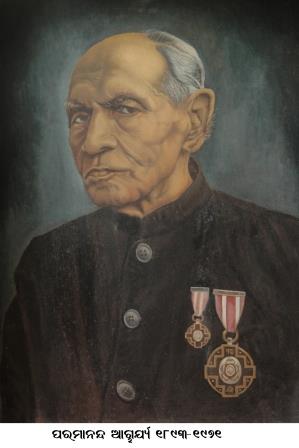Shree Paramananda Acharya
Died :- 11-Apr-1971
Place of Birth :- Baidyapur, Mayurbhanja

Paramananda Acharya is considered to be the pioneering Archaeologist of Odisha. He deserves a distinct place among those few men of letters in the first half of the 20th century who loboured hard to bring out the latent facets of the hoary past of Odisha into light and contributed immensely to the scientific writing of the history of Odisha.
Paramananda was born in Baidyapur village in 1893. After passing the M.E. examination from the Amarda M.E. School, he joined as a student of Baripada High School. He graduated from Kolkata University in 1923 with Botany Honours. As desired by Maharaja Purna Chandra Bhanjadeo, he gave up his Post Graduate study and joined the excavation work at Khiching to assist Ray Bahadur Ram Prasad Chanda in 1924. On 1 April, 1924, Paramananda joined the state service as Archaeological scholar. His first task was to maintain the Khiching and Kichakeshwari temples. After his appointment he took necessary steps for the protection of Archaeological remains of the temples and sites at Khiching. Next year (1925-26) he was sent for a month for training in the Government archaeological excavation at Paharpur in Rajasahi district of undivided Bengal (now in Bangladesh). In order to assign the real archaeological position of Khiching together with History, he focussed his attention to the neighbouring states and other parts of Odisha. He was later appointed as the senior archaeologist of the museum. He then took over the restoration of hariharpur palace at the behest of Maharaja Purnachandra Bhanjdeo. By 1934-35, Khiching became the centre of activities of the Archaeological Department of Mayurbhanj and the Ruler gave direction for construction of the new temple at Khiching. It was decided to restore the broken temple of Hara for the use of the Thakurani. The broken temple was so badly damaged that even its ground plan was disturbed. Paramananda and his Assistant S.P. Bose were able to find out the ground plans by piecing together the original stones and then reconstruction became easy.
In 1934 he attended the International Congress of the Anthropological and Ethnological Sciences held at London. During his stay in London he inspected records relating to the history of Mayurbhanj in the Indian Office from 1800 A.D. to 1825 A.D and brought some copies of the selected records. He also located the existence of the original inscription of Ananta Vasudev Temple of Bhubaneswar in the premises of the Royal Asiatic Society of Great Britain.
In the month of May, 1941, Paramananda Acharya was deputed to see the monuments and materials at Khandapara State. At the request of the rulers of Baramba and Narasinghpur he visited Banesvaranasi, Champesvar, Bhattarika, Simhanath and Ramchandi. During this visit he discovered a temple of unique style of architecture at Ramachandi near Baidesvar situated on the south of Simhanath. He also visited Ghumusar in the Ganjam district during the same year.
As he was the State Archaeologist of Mayurbhanj, he had several occasions to explore the antiquities scattered all over the princely states of Odisha. He discovered the biggest Hindu images of Anantasayi Vishnu at Saranga and Bhimkund in the old Talcher State. His survey of the Archaeological relics in the valleys of the Vaitarani, the Brahmani, and the Mahanadi had brought to light the archaeological wealth of Odisha.
Later, after the merger of Mayurbhanj with the state Odisha on 1 January, 1949, Parmanand was appointed as superintendent of the state’s archaeology department functioning at Ravenshaw College, which was later shifted to Bhubaneswar, and retired in 1950. On his retirement, he took over as superintendent of the Odisha State Museum. The acquisition of sculptures and art pieces by Paramananda Acharya and K.C. Panigrahi and their study enriched the antiquity collections of the museum caused to lay the foundation of three institutions i.e. Archaeology, Museum and Archives and Paramananda Acharya remained the pioneer of all these branches.
He was again re-employed as the Superintendent of Archaeology in 1955 and held the post till 1962. After retirement Paramananda Acharya devoted his time and energy for the study of palm leaf and Vedic manuscripts of Odisha.
Acharya is the author of several articles and two books, Essays in History, Culture, Archaeology of Odisha, and Studies in Orissan History, Archaeology and Archives. His writings are prescribed as reference books for graduate and post graduate studies at Ravenshaw University in Odisha. A commemorative volume, Life and culture in Orissa was published in 1984, compiling several of Acharya's writings. In recognition of his dedicated service to the cause of Odisha culture, the President of India conferred upon him ‘Padmashree’ in 1964.
Books
Copyright © 2024 Odia Virtual Academy. All rights reserved Total Visitors- 1
Powered by: Odia Virtual Academy

